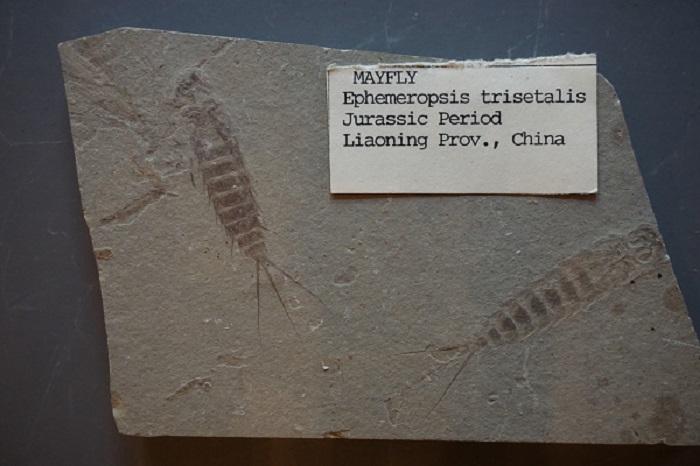Returning to our specimen from last week, this time with appropriate scale:

Doesn’t it look familiar? If any of you like flyfishing I’m sure it looks familiar. As you might have cleverly deduced from the picture, this specimen is an Ephemeropsis trisetalis; a type of mayfly.
The genus Ephermeroptera is alive and kicking, and has been since the Permian. These particular specimens date from the Jurassic (around 145–201 million years ago), and as you can see, they’re a bit bigger than modern mayflies, but not particularly enormous. Members of this genus were pretty darn big at various times in the past. The largest known—from the Carboniferous (259–299 million years ago), a popular time for giant insects—had a wingspan of 45 centimeters. Our specimen this week does not have wings at all because it is not an adult, but a nymph. We know it’s a nymph because it has one of the main visual characteristics of mayfly nymphs—a three-pronged tail.
These insects have interesting life cycles. Some species’ adult phases (subimago phases if you’re feeling fancy) last only for a few minutes. However, mayflies can live months or even years in their various aquatic sub-adult states. We don’t live in the water, so we're more familiar with the adults, which tend to appear all at once, showily breed, and then die. However, if you’ve ever looked in a clear creek, you’ve likely seen the nymphs scuttling around, looking sometimes larger and rather more dangerous, albeit in a tiny way, than the adults they will become.
We showcase many specimens on Fossil Friday that are interesting because they are so removed from our modern world. Some of the fossilized invertebrates in particular look almost completely foreign. It’s kind of interesting to see such a familiar-looking specimen. In quite a few ways, insects haven’t changed much in the last 300 million years, certainly in fewer obvious ways than my beloved plants. Were you to walk through a Jurassic forest, there would be lots of organisms you would not recognize at all, and the longer you looked at some familiar-ish things, like the trees, the stranger they would seem. However, the odds of your being bothered by completely recognizable (if perhaps terrifyingly gigantic) insects would be quite high.
The winner this week? Dan Coleman ( and with remarkable speed!). Frankly, I was impressed by how many people got this one, and how quickly. Clearly, I need to bone up on my bugs. Congratulations, Dan, and thanks for playing! If you have a fossil you want to share, send your pictures to me at schoerning at ncse.com

